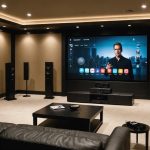Creating a harmonious multi-room audio system has never been easier, especially with the seamless integration of Sonos speakers and Google Home devices. This union allows you to enjoy continuous, high-quality sound throughout your entire home, controlled effortlessly from your smartphone or through voice commands. In this article, we’ll walk you through the steps to set up this combination and transform your home into a musical haven.
Understanding the Basics: Sonos and Google Home
Before diving into the setup process, it’s essential to understand the core components of your multi-room audio system: Sonos speakers and Google Home devices.
Topic to read : What specific steps should be taken to configure a secure IoT setup using a Netgear Nighthawk AX12?
Sonos speakers are renowned for their superior sound quality and user-friendly interface. They connect to your home Wi-Fi network and can be controlled via the Sonos app. One of the standout features of Sonos is its ability to sync multiple speakers, ensuring that your music plays uniformly throughout every room.
On the other hand, Google Home devices, powered by Google Assistant, offer smart home functionalities. These devices not only play music but also allow voice control over various smart home gadgets. When paired with Sonos speakers, Google Home can elevate your audio experience by providing hands-free voice commands.
Topic to read : What are the best methods for optimizing an Intel NUC for 4K media streaming using Kodi?
Understanding how these devices complement each other can help you make the most of your multi-room audio system, ensuring a seamless and enjoyable music experience.
Setting Up Your Sonos Speakers
The first step in crafting your multi-room audio system is setting up your Sonos speakers. Here’s how to do it:
- Unbox and Power Up: Start by unboxing your Sonos speakers and plugging them into a power source. Ensure they are placed in the desired locations within your home.
- Download the Sonos App: The Sonos app is available for both iOS and Android devices. Download and install the app on your smartphone or tablet.
- Connect to Wi-Fi: Open the Sonos app and follow the on-screen instructions to connect your speakers to your home Wi-Fi network. Ensure your Wi-Fi connection is stable and strong to avoid interruptions.
- Add Speakers: Within the app, add each speaker to your Sonos system. This process usually involves pressing a button on the speaker to allow it to be detected by the app.
- Group Speakers: Once all your speakers are added, you can group them together to play the same music simultaneously. This feature is perfect for creating a unified audio experience across multiple rooms.
- Adjust Settings: Customize the settings for each speaker according to your preferences. You can adjust the volume, EQ settings, and even set up stereo pairs for a richer sound experience.
By completing these steps, your Sonos speakers will be ready to deliver high-quality sound throughout your home. The next stage involves integrating Google Home devices to add voice control capabilities.
Integrating Google Home Devices
Now that your Sonos speakers are set up, it’s time to integrate Google Home devices into your system. Here’s how:
- Set Up Google Home: If you haven’t already, unbox your Google Home devices and plug them into a power source. Download the Google Home app on your smartphone or tablet.
- Connect to Wi-Fi: Open the Google Home app and follow the instructions to connect your devices to your home Wi-Fi network.
- Set Up Google Assistant: Ensure that Google Assistant is set up on your Google Home devices. This will enable voice commands for controlling your Sonos speakers.
- Link Sonos to Google Home: Open the Google Home app, go to the settings, and find the option to link your Sonos account. Follow the prompts to log into your Sonos account and allow permissions.
- Assign Rooms: In the Google Home app, assign each device to the appropriate room in your home. This helps Google Assistant to recognize and control each device accurately.
- Create Speaker Groups: For a truly unified audio experience, create speaker groups in the Google Home app. This allows you to play music on multiple devices simultaneously with a single command.
With Google Home integrated into your system, you can now control your Sonos speakers using voice commands. Whether it’s playing your favorite playlist or adjusting the volume, Google Assistant simplifies the process, making your multi-room audio experience more enjoyable.
Optimizing Your Multi-Room Audio Experience
Once your Sonos speakers and Google Home devices are set up and integrated, there are several ways to optimize your multi-room audio system:
- Voice Commands: Familiarize yourself with the range of voice commands available through Google Assistant. Commands such as “Hey Google, play jazz music in the living room” or “Hey Google, turn up the volume in the kitchen” can make controlling your system effortless.
- Sonos and Google Home App Features: Explore the features available in both the Sonos app and the Google Home app. For example, the Sonos app allows you to create custom playlists, while the Google Home app enables routine setups, so your favorite music can play at specific times of the day.
- Placement of Speakers: Ensure that your Sonos speakers are placed strategically around your home. For instance, placing speakers at ear level can enhance sound quality. Avoid placing them near obstacles that could obstruct the sound.
- Wi-Fi Network Stability: A strong and stable Wi-Fi connection is crucial for the seamless operation of your multi-room audio system. Consider using Wi-Fi extenders or mesh networks to improve coverage in larger homes.
- Firmware Updates: Regularly check for firmware updates for both Sonos speakers and Google Home devices. These updates often include performance improvements and new features.
- Audio Quality Settings: Take advantage of the audio quality settings available in the Sonos app. Adjust the EQ settings to match your audio preferences, whether you prefer more bass or clearer treble.
By following these tips, you can enhance the performance and functionality of your multi-room audio system, ensuring an immersive and enjoyable listening experience throughout your home.
Troubleshooting Common Issues
Even with the best setup, you might encounter some issues with your multi-room audio system. Here are some common problems and how to solve them:
- Connection Drops: If your Sonos speakers or Google Home devices keep disconnecting, check the stability of your Wi-Fi network. Make sure the devices are within range of your router, and consider using mesh Wi-Fi systems to improve connectivity.
- Voice Command Issues: If Google Assistant is not responding to your commands correctly, ensure that the microphones on your Google Home devices are not obstructed. Additionally, check the Google Home app settings to make sure the devices are assigned to the correct rooms.
- Syncing Problems: If the audio is not syncing properly between your Sonos speakers, use the Sonos app to re-group the speakers. Ensure that all devices are connected to the same Wi-Fi network.
- Sound Quality Concerns: If the sound quality is not up to your expectations, try adjusting the EQ settings in the Sonos app. Also, inspect the placement of your speakers to ensure they are not obstructed by furniture or walls.
- App Crashes: If the Sonos or Google Home app crashes frequently, make sure you have the latest version of the app installed. Restart your smartphone or tablet, and consider reinstalling the app if the problem persists.
By addressing these common issues, you can ensure that your multi-room audio system operates smoothly and delivers the high-quality sound experience you desire.
Setting up a multi-room audio system using a combination of Sonos speakers and Google Home devices can revolutionize how you experience music at home. By following the steps outlined in this article, you can create a seamless, high-quality audio experience that spans every room in your house. From the initial setup of your Sonos speakers to the integration and optimization of Google Home devices, each step is designed to provide a rich and immersive sound environment.
Whether you’re hosting a party, unwinding after a long day, or simply enjoying your favorite tunes, a well-configured multi-room audio system can make all the difference. With the power of Sonos and Google Home working together, you have the tools to create a truly connected and musical home.











